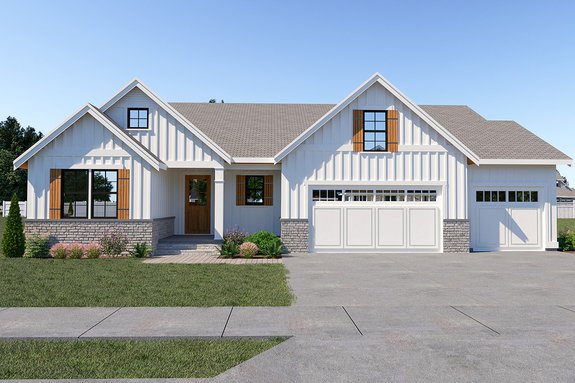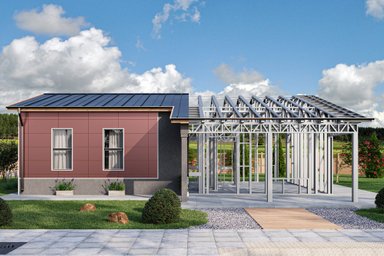By Boyce Thompson
It's fun looking through house plans, but what about when it comes time to actually build the home? Maybe you aren’t the kind of person who keeps a strict family budget, or even regularly balances a checkbook. But if you are planning to risk your savings on a half-million-dollar new home, it’s time to start acting more like an accountant. You need to develop a budget and stick to it closely. If you are borrowing money to build, your lender will want to see one.
Click here to browse our collection of new and popular house floor plans or view our Cost-to-Build Report.
Did you know that we've got a dedicated team of plan experts? Whether you need a specific piece of information about a plan or you simply want to talk about your dream home - we are here for you. Call 1-800-913-2350 today.
What’s disturbing about new-home budgets is that they are notoriously exceeded. That’s why lenders recommend adding a contingency fee of 15 to 20 percent. You have hundreds of product decisions to make, and you may decide halfway through the project that you really want to upgrade to solid-surface countertops or multiple showerheads. Home building chat boards are littered with stories about owners who forgot to budget for landscaping, garden walls, or beefed-up foundations.
 Plan 1070-32
Plan 1070-32
Some house plans have material quantity lists available that builders can use to prepare bids. The best bids from builders – you want at least three – isolate material from labor costs, so if budgets are exceeded you can determine the cause. Pay particular attention to the builder’s proposed finish level in the kitchen and bathrooms, the most expensive rooms to build. And remember: most house plans don’t include an HVAC or electrical plan. You, or your builder, will have to bid that work separately.
Your winning builder’s bid document will form a big part of your budget. But it’s not enough to just come up with numbers – you need to keep track of deviations as they occur. So many purchasing decisions are made during the course of a project that it’s easy to forget a big one. Most builders generate a change order when you deviate from your contract. Whether you pay the change order now or later, at least you have a record. The last thing you want is a big budget-busting surprise at the end.
Hard Versus Soft Costs
When it comes to budgeting, it’s convenient to think in terms of hard and soft costs. Hard costs would be the cost to build the structure, including what you pay the builder. Soft costs would be what you pay for land, engineering, government permits, taxes, and anything else that isn’t bricks and mortar. Soft costs can easily equal half the cost of the project.
 Plan 1070-29
Plan 1070-29
A 2017 cost of construction survey by the National Association of Home Builders provides a detailed breakdown. It puts the average cost to build a new home at $427,892, including the builder’s profit and the cost of the lot, the latter accounting for, on average, 21.5 percent of the finished home value, though it may be much higher in New England and Pacific regions. Here’s how the survey breaks things down if a builder were building a home on speculation and selling it to you.
Finished lot, including financing cost $91,996 21.5%
Total construction cost $237,760 55.6%
Financing cost $7,636 1.8%
Overhead and profit $67,737 15.8%
Marketing cost $5,314 1.2%
Sales commission $17,448 4.1%
Total sales price $427,892 100%
Report data from NAHB's 2017 Construction Cost survey
The cost structure is different when you hire a builder to build your home plan. You won’t have the builder’s “marketing costs,” and you won’t have to pay a sales commission. But you will have the cost to buy a house plan and you may need to pay an engineer to stamp your drawings. And you may have additional landscaping expenses that aren’t captured in the survey.
 Plan 923-125
Plan 923-125
Ordering a Cost to Build report from Houseplans.com may be a better way to develop budgeting guideposts.
 Plan 923-123
Plan 923-123
Your lot is another big budget variable. House plans typically come with a foundation plan for a relatively flat lot.
Don’t forget the cost of clearing the lot for construction. In the NAHB survey, site work costs on average $15,903. Civil engineers need to inspect the property, determine where the house should go, and how the site should be graded for drainage. Then you’ll need a contractor to clear brush and trees, remove topsoil for the home and driveway, and grade the site for drainage.
 Plan 23-2443
Plan 23-2443
The Cost to Build reports are customized by market. Most local governments publish a fee schedule, but it’s not always easy to decipher. Some jurisdictions, for instance, charge separate fees for building pools. Some charge big fees to cover the impact your home will have on public infrastructure. Your builder probably has a good idea the government fees that you’d be expected to pay.
It’s impossible, of course, to budget exactly for a new-home project. There are just too many complex variables. But going into the project with an understanding of the scope of expenses reduces the potential for heartache and name-calling in the end.
View our Cost-to-Build Report
Browse popular plans
Questions? Call 1-800-913-2350 or contact us here






